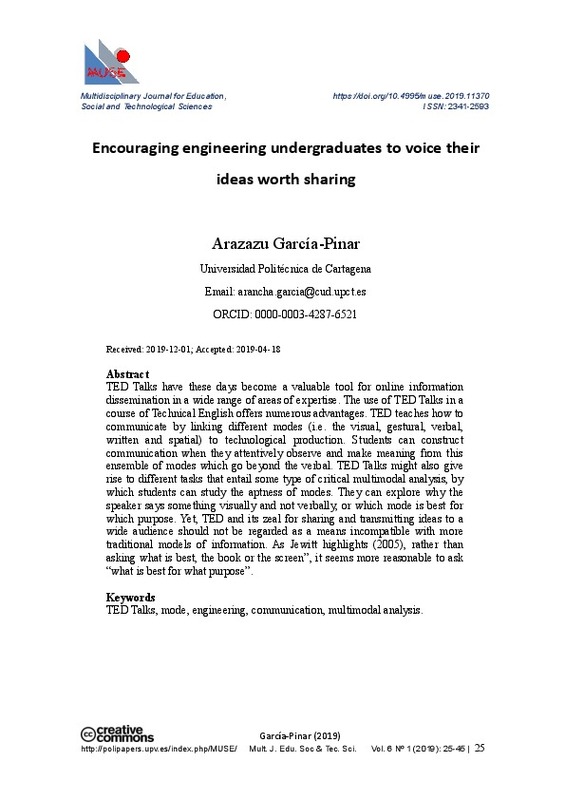Anderson, C. (2017). TED: The Official TED Guide to Public Speaking. Boston: Houghton Mifflin Harcourt.
Brazil, D. (1985). The Communicative Value of Intonation in English. Birmingham: The University Printers, University of Birmingham
Briñol, P. & Petty, R. E. (2003). Overt head movements and persuasion: A self-validation analysis. Journal of Personality and Social Psychology, 84, 1123-1139. https://doi.org/10.1037/0022-3514.84.6.1123
[+]
Anderson, C. (2017). TED: The Official TED Guide to Public Speaking. Boston: Houghton Mifflin Harcourt.
Brazil, D. (1985). The Communicative Value of Intonation in English. Birmingham: The University Printers, University of Birmingham
Briñol, P. & Petty, R. E. (2003). Overt head movements and persuasion: A self-validation analysis. Journal of Personality and Social Psychology, 84, 1123-1139. https://doi.org/10.1037/0022-3514.84.6.1123
Campoy-Cubillo, M.C. (2016). Multimodal Listening Skills: Issues in Assessment and Implementation. In V. Bonsignori & B. Crawford Camiciottoli (Eds.), Multimodality across Communicative Settings, Discourse Domains and Genres (pp. 14-36). Cambridge: Cambridge Scholars Publishing.
Chun, D. M. 2002. Discourse Intonation in L2: From Theory and Research to Practice. J. Benjamins. https://doi.org/10.1075/lllt.1
Council of Europe. (2001). Common European framework of reference for languages: Learning, teaching, assessment. Cambridge, U.K: Press Syndicate of the University of Cambridge.
Elk, C. K. (2014). Beyond mere listening comprehension: Using TED Talks and metacognitive activities to encourage awareness of error. International Journal of Innovation in English Language Teaching and Research, 3(2), 215.
Hadar, U., Steiner T.J., Grant E.C. & Rose, F.C. (1984). The timing of shifts of head postures during conservation. Human Movement Science, 3 (3), 237-245. https://doi.org/10.1016/0167-9457(84)90018-6
Hall, E.T. (1966). The Hidden Dimension. New York: Doubleday.
Halliday, M.A.K. & Greaves, S. (2008). Intonation in the Grammar of English. London: Equinox.
Hostetter, A. B., & Alibali, M. W. (2010). Language, gesture, action! A test of the Gesture as Simulated Action framework. Journal of Memory and Language, 63, 245-257. https://doi.org/10.1016/j.jml.2010.04.003
Hincks, R., & Edlund, J. (2009). Promoting Increased Pitch Variation in Oral Presentations with Transient Visual Feedback. Language Learning & Technology, 13(3), 32-50.
Kress, G., & van Leeuwen, T. (1996). Reading Images: The Grammar of Visual Design. London: Routledge.
Kress, G., & van Leeuwen, T. (2001). Multimodal Discourse: The Modes and Media of Contemporary Communication Discourse. London: Arnold.
Kress, G. (2005). Gains and Losses: New Forms of Texts, Knowledge, and Learning. Computers and Composition, 22(1), 5-22. https://doi.org/10.1016/j.compcom.2004.12.004
Lakoff, G. & Johnson, M. (1980). Metaphors We Live By. Chicago and London: University of Chicago Press.
Lee, A. (2013, April). Angela Lee: Grit: The power of passion and perseverance [Video file].Retrieved from www.ted.com/talks/angela_lee_duckworth_grit_the_power_of_passion_and_perseverance.
Loya, M. & Klemm, T. (2016). Teaching Note-Using TED Talks in the Social Work Classroom: Encouraging Student Engagement and Discourse. Journal of Social Work Education, 52, 4, 518-523. https://doi.org/10.1080/10437797.2016.1198291
McClave, E. (2000). Linguistic Functions of Head Movements in the Context of Speech. Journal of Pragmatics, 32, 855-78. https://doi.org/10.1016/S0378-2166(99)00079-X
McGregor, A., Zielinski, B., Meyers, C., & Reed, M. (2016). An Exploration of Teaching Intonation Using a TED Talk. In J. Levis, H. Le., I. Lucic, E. Simpson, & S. Vo (Eds.), Proceedings of the 7th Annual Conference of Pronunciation in Second Language Leaning and Teaching (PSLLT) (pp.143-159). Ames IA: Iowa State University.
McNeill, D. (1992). Hand and mind: What gestures reveal about thought. Chicago: University of Chicago Press.
McNeill, D. (2005). Gesture and Thought. Chicago: University of Chicago Press. https://doi.org/10.7208/chicago/9780226514642.001.0001
Norris, S. (2004). Analysing Multimodal Interaction: A methodological framework. New York: Routledge. https://doi.org/10.4324/9780203379493
Kendon, A. (1980). Gesticulation and Speech: Two Aspects of the Process of Utterance. In Mary. R. Key (Ed). The relationship of verbal and non-verbal communication (pp 207-27).The Hague: Mouton.
Kendon, A. (2002). Some Uses of the Head Shake. Gesture, 2(2), 147-82. https://doi.org/10.1075/gest.2.2.03ken
Pink, D. (2019, July). Dan Pink: The puzzle of motivation are [Video file]. Retrieved from https://www.ted.com/talks/dan_pink_on_motivation.
Pinker, S. (2014). The Sense of Style: The thinking Person's Guide to Writing in the 21st Century. New York: Penguin Books.
Poyatos, F. (1983). Language and Nonverbal Sign Systems in the Structure of Face to Face Interaction. Language and Communication, 3(2), 129-40. https://doi.org/10.1016/0271-5309(83)90010-1
Robinson, K. (2006, February). Ken Robinson: Do schools kill creativity? [Video file]. Retrieved from https://www.ted.com/talks/ken_robinson_says_schools_kill_creativity.
Rubenstein,L. (2012) Using TED Talks to Inspire Thoughtful Practice. The Teacher Educator, 47(4), 261-267. https://doi.org/10.1080/08878730.2012.713303
Sinek, S. (2009, September). Simon Sinek: How great leaders inspire action [Video file]. Retrieved from www.ted.com/talks/simon_sinek_how_great_leaders_inspire_action.
Sueyoshi, A., & Hardison, D. (2005). The role of gestures and facial cues in second language listening comprehension. Language Learning, 55(4), 661-699. https://doi.org/10.1111/j.0023-8333.2005.00320.x
Sugimoto, C., & Mike T. (2013). Scholars on Soap Boxes: Science Communication and Dissemination via TED Videos. The Journal of the American Society for Information Science & Technology, 64(4), 663-74. https://doi.org/10.1002/asi.22764
Takaesu, A. (2013). TED Talks as an Extensive Listening Resource for EAP Students. Language Education in Asia, 4(2), 150-162. https://doi.org/10.5746/LEiA/13/V4/I2/A05/Takaesu
Valeiras-Jurado, J. (2017). A multimodal approach to persuasion in oral presentations : the case of conference presentations, research dissemination talks and product pitches. Universitat Jaume I ; Ghent University. Faculty of Arts and Philosophy, Castellón de la Plana, Spain ; Ghent, Belgium
van Edwards V. (2015). 5 Secrets of a successful TED talk. Retrieved from: http://www.scienceofpeople.com/2015/03/secrets‐of‐a‐successful‐ted‐talk/
van Leeuwen, T. (1999). Speech, Music, Sound. London: Macmillan. https://doi.org/10.1007/978-1-349-27700-1
van Leeuwen, T. (2005). Introducing Social Semiotics. London/New York: Routledge. https://doi.org/10.4324/9780203647028
van Leeuwen, T. (2011). The Language of Colour. Oxon/ New York: Routledge.
van Lier, L. (2007). Action-based teaching, autonomy and identity. International Journal of Innovation in Language Learning and Teaching, 1(1), 46-65. https://doi.org/10.2167/illt42.0
Weinberg, A., Fukawa-Connelly, T., & Wiesner, E. (2013). Instructor gestures in proofbased mathematics lectures. In M. Martinez, & A. Castro Superfine (Eds.), Proceedings of the 35th annual meeting of the North American Chapter of the International Group for the Psychology of Mathematics Education (p. 1119). Chicago: University of Illinois at Chicago.
Young, K. & Travis, H. (2012). Oral Communication: Skills, Choices and Consequences. Long Grove, IL: Waveland Press, Inc.
[-]








